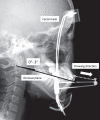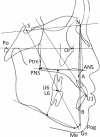A comparative assessment of orthodontic treatment outcomes of mild skeletal Class III malocclusion between facemask and facemask in combination with a miniscrew for anchorage in growing patients: A single-center, prospective randomized controlled trial
- PMID: 31398066
- PMCID: PMC8087061
- DOI: 10.2319/101718-750.1
A comparative assessment of orthodontic treatment outcomes of mild skeletal Class III malocclusion between facemask and facemask in combination with a miniscrew for anchorage in growing patients: A single-center, prospective randomized controlled trial
Abstract
Objectives: To investigate the hypothesis that there is difference in the treatment outcomes of milder skeletal Class III malocclusion between facemask and facemask in combination with a miniscrew in growing patients.
Materials and methods: Patients were randomly divided into two groups. In one group, the patients were treated with facemask therapy (FM group: 12 males, eight females, average age: 10 years, 5 months ± 1 year, 8 months). In the other group, patients were treated with facemask therapy along with a miniscrew (FM+MS group: 12 males, seven females, average age: 11 years, 1 month ± 1 year, 3 months). A lingual arch with hooks was fixed to the maxillary arch in both groups and a protractive force of 500 g was applied from the facemask to the hooks. The patients were instructed to use the facemask for 12 hours per day. In the FM+MS group, a miniscrew was inserted into the palate and fixed to the lingual arch.
Results: Mobility and loosening of the miniscrew were not observed during treatment. Lateral cephalometric analysis showed that SNA, SN-ANS, and ANB values were significantly increased in the FM+MS group compared with those for the FM group (SNA, 1.1° SN-ANS, 1.3° ANB, 0.8°). Increase in proclination of maxillary incisors was significantly greater in the FM group than in the FM+MS group (U1-SN, 5.0°).
Conclusions: During treatment of milder skeletal Class III malocclusion, facemask therapy along with a miniscrew exhibits fewer negative side effects and delivers orthopedic forces more efficiently to the maxillary complex than facemask therapy alone.
Keywords: Absolute anchorage; Class III malocclusion; Facemask therapy; Maxillary protraction; Miniscrew.
Figures






References
-
- Roberts CA, Subtenly JD. An American Board of Orthodontics case report. Use of mask in treatment of maxillary skeletal retrusion. Am J Orthod Dentofacial Orthop. 1988;93:388–394. - PubMed
-
- Nanda R. Biomechanical and clinical considerations of modified protraction headgear. Am J Orthod. 1980;78:125–139. - PubMed
-
- Kama JD, Ozer T, Baran S. Orthodontic and orthopaedic changes associated with treatment in subjects with class III malocclusions. Eur J Orthod. 2006;28:496–502. - PubMed
-
- Roberts WE, Engen DW, Schneider PM, Hohlt WF. Implant-anchored orthodontics for partially edentulous malocclusions in children and adults. Am J Orthod Dentofacial Orthop. 2004;126:302–304. - PubMed
-
- Kuroda S, Sugawara Y, Tamamura N, Takano-Yamamoto T. Anterior open bite with Temporomandibular disorder treated with titanium screw anchorage: evaluation of morphological and functional improvement. Am J Orthod Dentofacial Orthop. 2007;131:550–560. - PubMed
Publication types
MeSH terms
LinkOut - more resources
Full Text Sources
Medical
Research Materials

